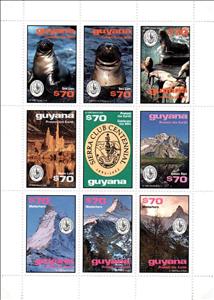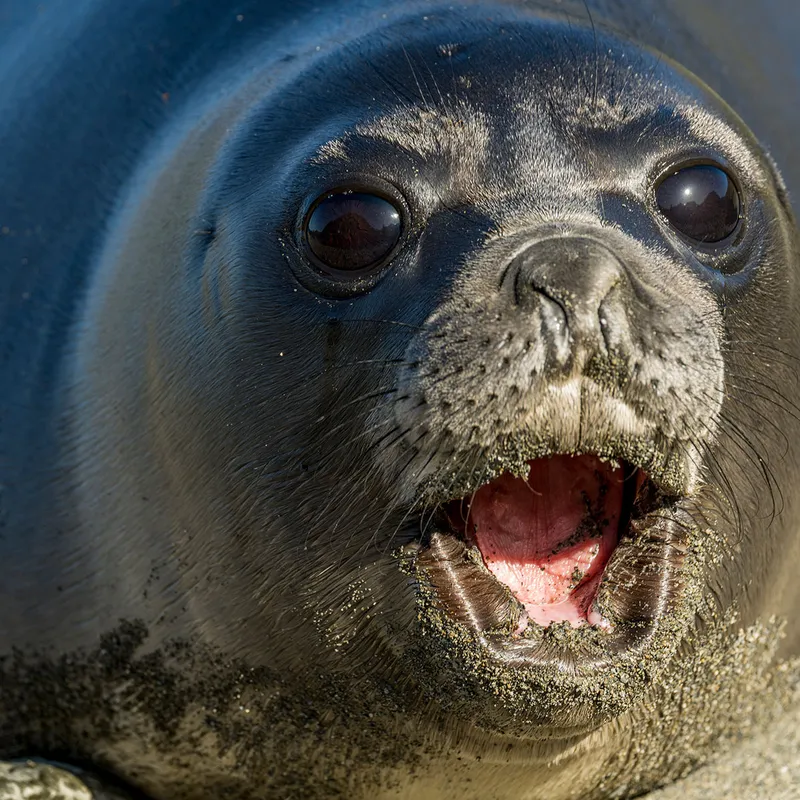Mini Sheet: Sea Lions, etc. (Guyana 1994)
Sea Lions, etc. (Guyana 1994)
20 May (Guyana ) within release Centenary of the Sierra Club goes into circulation Mini Sheet Sea Lions, etc. face value 9*70 Guyanese dollar
| Mini Sheet Sea Lions, etc. in catalogues | |
|---|---|
| Stanley Gibbons: | Sg: GY 3864a |
Mini Sheet is square format.
Also in the issue Centenary of the Sierra Club:
- Mini Sheet - Kangaroo with young, Alligator, etc. face value 8*70;
- Mini Sheet - Sea Lions, etc. face value 9*70;
- Mini Sheet - Kangaroo, Whooping Crane, etc. face value 8*70;
- Mini Sheet - Alligator, Alligator, etc. face value 6*70;
- Stamp - Alaskan Brown Bear and Cub face value 70;
- Stamp - Alaskan Brown Bear Fishing face value 70;
- Stamp - Alaskan Brownbear face value 70;
- Stamp - American Alligator (Logo at Left) face value 70;
- Stamp - American Alligator (Logo at Right) face value 70;
- Stamp - Bald Eagle face value 70;
- Stamp - Bald Eagle on Branch face value 70;
- Stamp - Clouds over Matterhorn face value 70;
- Stamp - Giant Panda face value 70;
- Stamp - Giant Panda Eating Bamboo face value 70;
- Stamp - Head of American Alligator face value 70;
- Stamp - Head of Bald Eagle face value 70;
- Stamp - Head of Bald Eagle face value 70;
- Stamp - Head of Giant Panda face value 70;
- Stamp - Head of Sea Lion face value 70;
- Stamp - Italian Alps and Meadow face value 70;
- Stamp - Italian Alps at Sunrise face value 70;
- Stamp - Lake, Italian Alps face value 70;
- Stamp - Matterhorn and Village face value 70;
- Stamp - Mono Lake at Sunset face value 70;
- Stamp - Red Kangaroo face value 70;
- Stamp - Red Kangaroo with Young face value 70;
- Stamp - Rock Pinnacles, Mono Lake face value 70;
- Stamp - Rock Pinnacles, Mono Lake face value 70;
- Stamp - Sea Lion face value 70;
- Stamp - Sea Lions on Rocks face value 70;
- Stamp - Sierra Club Centennial Emblem face value 70;
- Stamp - Summit of Matterhorn face value 70;
- Stamp - Whooping Crane Facing Left face value 70;
- Stamp - Whooping Crane in Courtship Display face value 70;
- Stamp - Whooping Crane Looking Right face value 70;
Mini Sheet Sea Lions, etc. it reflects the thematic directions:
Animals are multicellular, eukaryotic organisms of the kingdom Animalia (also called Metazoa). All animals are motile, meaning they can move spontaneously and independently, at some point in their lives. Their body plan eventually becomes fixed as they develop, although some undergo a process of metamorphosis later on in their lives. All animals are heterotrophs: they must ingest other organisms or their products for sustenance.
A landscape is the visible features of an area of land, its landforms and how they integrate with natural or man-made features. A landscape includes the physical elements of geophysically defined landforms such as (ice-capped) mountains, hills, water bodies such as rivers, lakes, ponds and the sea, living elements of land cover including indigenous vegetation, human elements including different forms of land use, buildings and structures, and transitory elements such as lighting and weather conditions. Combining both their physical origins and the cultural overlay of human presence, often created over millennia, landscapes reflect a living synthesis of people and place that is vital to local and national identity. The character of a landscape helps define the self-image of the people who inhabit it and a sense of place that differentiates one region from other regions. It is the dynamic backdrop to people’s lives. Landscape can be as varied as farmland, a landscape park, or wilderness. The earth has a vast range of landscapes, including the icy landscapes of polar regions, mountainous landscapes, vast arid desert landscapes, islands and coastal landscapes, densely forested or wooded landscapes including past boreal forests and tropical rainforests, and agricultural landscapes of temperate and tropical regions.
Mammals are any vertebrates within the class Mammalia (/məˈmeɪli.ə/ from Latin mamma "breast"), a clade of endothermic amniotes distinguished from reptiles (including birds) by the possession of a neocortex (a region of the brain), hair, three middle ear bones and mammary glands. All female mammals nurse their young with milk, secreted from the mammary glands. Mammals include the largest animals on the planet, the great whales. The basic body type is a terrestrial quadruped, but some mammals are adapted for life at sea, in the air, in trees, underground or on two legs. The largest group of mammals, the placentals, have a placenta, which enables the feeding of the fetus during gestation. Mammals range in size from the 30–40 mm (1.2–1.6 in) bumblebee bat to the 30-meter (98 ft) blue whale. With the exception of the five species of monotreme (egg-laying mammals), all modern mammals give birth to live young. Most mammals, including the six most species-rich orders, belong to the placental group. The largest orders are the rodents, bats and Soricomorpha (shrews and allies). The next three biggest orders, depending on the biological classification scheme used, are the Primates (apes and monkeys), the Cetartiodactyla (whales and even-toed ungulates), and the Carnivora (cats, dogs, seals, and allies).
Marine mammals are mammals that rely on marine (saltwater) ecosystems for their existence. They include animals such as cetaceans (whales, dolphins and porpoises), pinnipeds (seals, sea lions and walruses), sirenians (manatees and dugongs), sea otters and polar bears. They are an informal group, unified only by their reliance on marine environments for feeding and survival.
Marine life, or sea life or ocean life, refers to the plants, animals and other organisms that live in the salt water of the sea or ocean, or the brackish water of coastal estuaries. At a fundamental level, marine life helps determine the very nature of our planet. Marine organisms produce much of the oxygen we breathe. Shorelines are in part shaped and protected by marine life, and some marine organisms even help create new land. Altogether there are 230,000 documented marine species, including over 16,000 species of fish, and it has been estimated that nearly two million marine species are yet to be documented. Marine species range in size from the microscopic, including plankton and phytoplankton which can be as small as 0.02 micrometres, to huge cetaceans (whales, dolphins and porpoises) which in the case of the blue whale reach up to 33 metres (109 feet) in length, being the largest known animal.
Pinnipeds (pronounced /ˈpɪnɪˌpɛdz/), commonly known as seals, are a widely distributed and diverse clade of carnivorous, fin-footed, semiaquatic, mostly marine mammals. They comprise the extant families Odobenidae (whose only living member is the walrus), Otariidae (the eared seals: sea lions and fur seals), and Phocidae (the earless seals, or true seals), with 34 extant species and more than 50 extinct species described from fossils. While seals were historically thought to have descended from two ancestral lines, molecular evidence supports them as a monophyletic group (descended from one ancestor). Pinnipeds belong to the suborder Caniformia of the order Carnivora; their closest living relatives are musteloids (weasels, raccoons, skunks and red pandas), having diverged about 50 million years ago.






